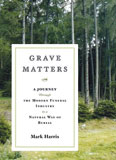 click to purchase
|
Grave Matters: A Journey Through The Modern Funeral Industry To A Natural Way Of Burial
By Mark Harris
Publisher: Scribner
"Will We Need A Superfund To Clean Up Our Cemeteries?" could be another subtitle to this intriguing book. Mark Harris discusses the evolution of modern American funeral practices while extolling past and environmentally sensitive customs. A simple burial in a shroud or hand-made pine coffin, burial at sea, the home funeral, backyard burial and the emerging natural cemetery movement were and are intended to return a body naturally to the earth.
But here's where it gets interesting. The American way of death may inadvertently be creating toxic landfills. It all starts when two million bodies are embalmed annually in hundreds of thousands of gallons of formaldehyde, a potential carcinogen. About 20% of those bodies are then encased in 45 million board ft of bronze or copper-trimmed oak, cherry or maple caskets coated with methyls and xylene, which generate toxic emissions during manufacturing. The majority of bodies are buried either in mahogany, a hardwood that is becoming a depleted resource when cut from tropical rainforests, or tons of solid bronze, copper or steel caskets. Most caskets will then be placed in a total of 1.5 million tons of lined or unlined concrete outer burial containers to prevent water intrusion and ground settlement.
Until the mid-1800s, Americans used to be buried in plain, octagonal "toe-pincher" coffins. But newer rectangular coffins were found to be more genteel and aesthetically pleasing. They then became referred to as a casket, a contemporary term for a jewelry box that contains a precious object.
Harris' point that "cemeteries bear the chemical legacy of their embalmed dead, and well after their graves have been closed" gives pause for thought. Before formaldehyde, there was arsenic, which had been used for parlor viewings. Its legacy survives in the soil, groundwater and surface water around older cemeteries. Given that there are about 22,000 cemeteries in America, could our current way of burial be a leaching environmental time bomb? An Oct. 5, 2006 article, "Dead Reckoning What's In Your Water?" published in the Emmitsburg, Md., Dispatch opens with a story about a New Jersey woman who may have been sickened by formaldehyde-contaminated drinking water. The piece goes on to discuss potential environmental cemetery dangers stemming from pesticides, herbicides, fuel and oil used in upkeep, as well as from viruses and bacteria released by bodies. The article closed with some suggestions to safeguard public health, including water testing, liners and possibly remediation.
Harris' reporting should force everyone to start facing some basic facts: a cemetery located over an aquifer is bound to leak something. Shouldn't the proper local or state agencies take a proactive approach now and start testing cemetery soil and groundwater? Shouldn't they begin recording data on a national basis to measure and identify potential problems now? Shouldn't they assign jurisdictions to implement the work now? Lots of questions but no answers, yet.
